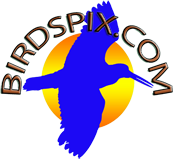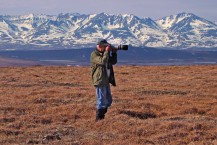August 31 – September 6: The recent California trip produced seven new ABA species (numbered), one additional new “non-countable” species, and three new subspecies. I flew to San Diego on 8/30 to meet Bob Mustell, my good friend from the Nome/Gambell trip in 2012. We checked in at the Best Western in Chula Vista, just one block off I-5, and a strategic location for the birding venues we planned to visit while in the San Diego area.
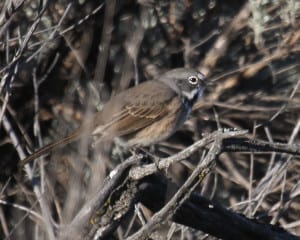 The following morning we set out before dawn for the Salton Sea, with a pre-planned stop en route just off I-8 at Kitchen Creek Road to look for the recently split Bell’s Sparrow (1). It was still cool when we arrived, and there was no activity yet, but as soon as the sun rose over the hills to the east a few birds began to stir, and the first individual I was able to spot was actually a Bell’s Sparrow, but they are not singing at this time of year and tend to stay low to the ground in dense brush where they are difficult to see. We managed to spot a total of four, but it took
The following morning we set out before dawn for the Salton Sea, with a pre-planned stop en route just off I-8 at Kitchen Creek Road to look for the recently split Bell’s Sparrow (1). It was still cool when we arrived, and there was no activity yet, but as soon as the sun rose over the hills to the east a few birds began to stir, and the first individual I was able to spot was actually a Bell’s Sparrow, but they are not singing at this time of year and tend to stay low to the ground in dense brush where they are difficult to see. We managed to spot a total of four, but it took 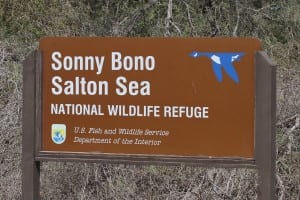 over an hour to get a single decent photo of one. This arid sage habitat also featured a cooperative Brewer’s Sparrow and a juvenile Black-throated Sparrow not yet sporting its namesake black throat. We arrived at the Sonny Bono Salton Sea Visitors Center at 10 AM although we knew it would be closed on Sunday, but it is the gateway to the unpaved side roads that run for several miles along the perimeter of the water. It was not our purpose to tally all the thousands of birds visible from the various vantage points, but rather to concentrate on a few species – especially the
over an hour to get a single decent photo of one. This arid sage habitat also featured a cooperative Brewer’s Sparrow and a juvenile Black-throated Sparrow not yet sporting its namesake black throat. We arrived at the Sonny Bono Salton Sea Visitors Center at 10 AM although we knew it would be closed on Sunday, but it is the gateway to the unpaved side roads that run for several miles along the perimeter of the water. It was not our purpose to tally all the thousands of birds visible from the various vantage points, but rather to concentrate on a few species – especially the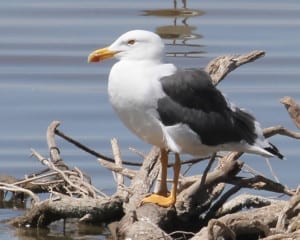 Yellow-footed Gull, (2) which breeds in Mexico in the Sea of Cortez and is found nowhere else in the United States. This gull’s very large size and dark mantle, as well as its striking bright yellow legs make it easy to pick out from the dozens of other gulls, terns, pelicans, godwits, avocets, herons, stilts, and sandpipers that crowd the landscape here. I also spent some time photographing Black Terns, a species I don’t often get a chance to see, but we never did find a large-billed Savannah Sparrow, a subspecies not found in many other places.
Yellow-footed Gull, (2) which breeds in Mexico in the Sea of Cortez and is found nowhere else in the United States. This gull’s very large size and dark mantle, as well as its striking bright yellow legs make it easy to pick out from the dozens of other gulls, terns, pelicans, godwits, avocets, herons, stilts, and sandpipers that crowd the landscape here. I also spent some time photographing Black Terns, a species I don’t often get a chance to see, but we never did find a large-billed Savannah Sparrow, a subspecies not found in many other places.
The desolate dry brown topography on the way to the Salton 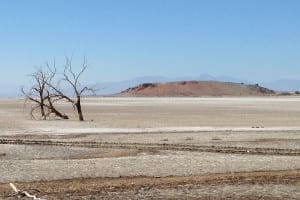 Sea recalled the Judean hills on the way to the Dead Sea, but the smell at one particular location at the Salton Sea was an order of magnitude worse. While the Dead Sea does have a general rotten egg sulfurous odor, this spot was more like ten pig farms. Then a bit later the car registered a peak outside temperature of 113 degrees. On the way back to San Diego we stopped again at Kitchen Creek Road in hopes of getting some more Bell’s Sparrow photos, but this time we saw just California Towhee, California Thrasher, two Phainopeplas, and some Western Scrub-Jays, but not a single sparrow of any kind.
Sea recalled the Judean hills on the way to the Dead Sea, but the smell at one particular location at the Salton Sea was an order of magnitude worse. While the Dead Sea does have a general rotten egg sulfurous odor, this spot was more like ten pig farms. Then a bit later the car registered a peak outside temperature of 113 degrees. On the way back to San Diego we stopped again at Kitchen Creek Road in hopes of getting some more Bell’s Sparrow photos, but this time we saw just California Towhee, California Thrasher, two Phainopeplas, and some Western Scrub-Jays, but not a single sparrow of any kind.
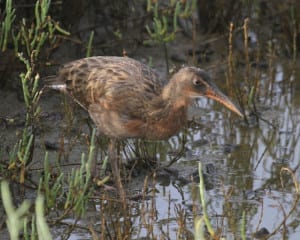 On Monday morning we had time to scope out Tijuana Slough NWR before checking in at 11 AM for the pelagic trip’s 12 noon departure. This expanse of protected marshland near the Mexican border offers a chance to see the light-footed subspecies of Ridgway’s Rail (3), recently split from Clapper Rail. We soon spotted a Ridgway’s on a mud flat at the end of the North McCoy Trail and, although we would get better views of others later in the trip, we observed this one swimming (rails do not have webbed feet and I never knew they could swim).
On Monday morning we had time to scope out Tijuana Slough NWR before checking in at 11 AM for the pelagic trip’s 12 noon departure. This expanse of protected marshland near the Mexican border offers a chance to see the light-footed subspecies of Ridgway’s Rail (3), recently split from Clapper Rail. We soon spotted a Ridgway’s on a mud flat at the end of the North McCoy Trail and, although we would get better views of others later in the trip, we observed this one swimming (rails do not have webbed feet and I never knew they could swim).
By 11:30 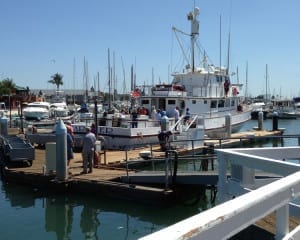 AM, we were settled in aboard the 95 foot “Searcher” and after a brief introductory talk were on our way out of the harbor promptly at noon. Most of the birds on the way out are Western and Heermann’s Gulls, Brown Pelicans,
AM, we were settled in aboard the 95 foot “Searcher” and after a brief introductory talk were on our way out of the harbor promptly at noon. Most of the birds on the way out are Western and Heermann’s Gulls, Brown Pelicans,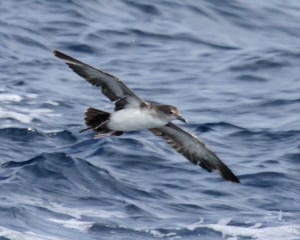 Elegant and Common Terns, and Brandt’s Cormorants, but once out of the harbor it wasn’t too long before we had our first Black-vented Shearwaters (4), the shearwater species most likely to be found relatively close to land. The weather was perfect and the sea gentle, ideal for spotting birds sitting on the water,
Elegant and Common Terns, and Brandt’s Cormorants, but once out of the harbor it wasn’t too long before we had our first Black-vented Shearwaters (4), the shearwater species most likely to be found relatively close to land. The weather was perfect and the sea gentle, ideal for spotting birds sitting on the water,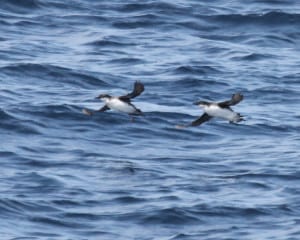 and a few miles later we were treated to the first of several pairs of Craveri’s Murrulets (5), an infrequently seen small alcid and one of the trip’s most hoped for species. A few Red-necked Phalaropes and a molting, bedraggled-looking Northern Fulmar were spotted,
and a few miles later we were treated to the first of several pairs of Craveri’s Murrulets (5), an infrequently seen small alcid and one of the trip’s most hoped for species. A few Red-necked Phalaropes and a molting, bedraggled-looking Northern Fulmar were spotted,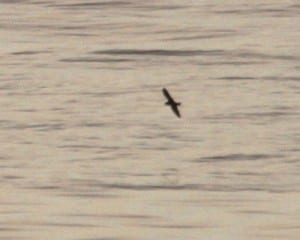 and storm-petrels began to appear – mainly Black Storm-Petrels, but on this first afternoon also some Ashys, and later, just as it began to get dark, a small number of Least Storm-Petrels (6). Least Storm-Petrels are tiny and these were seen in waning light from a long distance, but their tiny relative size, nighthawk-like dipping flight, and tailless appearance made them readily identifiable.
and storm-petrels began to appear – mainly Black Storm-Petrels, but on this first afternoon also some Ashys, and later, just as it began to get dark, a small number of Least Storm-Petrels (6). Least Storm-Petrels are tiny and these were seen in waning light from a long distance, but their tiny relative size, nighthawk-like dipping flight, and tailless appearance made them readily identifiable.
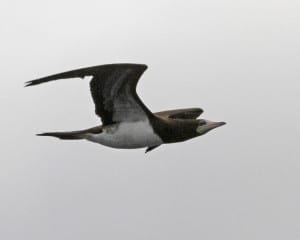 By the second day Pink-footed Shearwaters had replaced Black-vented as the dominant shearwater species, and we also logged a few Leach’s Storm-Petrels, although the dominant Storm-Petrel species continued to be the Black. Five Black-footed Albatrosses, fifteen Red-necked phalaropes, and six Sabine’s Gulls were seen, as well as all three jaegers and three South Polar Skuas with their telltale white wing arcs. Shortly after anchoring for the night the second of the trip’s three Brown Boobies flew around the boat.
By the second day Pink-footed Shearwaters had replaced Black-vented as the dominant shearwater species, and we also logged a few Leach’s Storm-Petrels, although the dominant Storm-Petrel species continued to be the Black. Five Black-footed Albatrosses, fifteen Red-necked phalaropes, and six Sabine’s Gulls were seen, as well as all three jaegers and three South Polar Skuas with their telltale white wing arcs. Shortly after anchoring for the night the second of the trip’s three Brown Boobies flew around the boat.
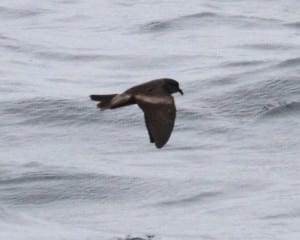 The third day added Buller’s and Sooty to the list of shearwater species, and we had no less than ten Red-billed Tropicbird flyovers at various times during the day. On both this and the fourth (last) day we had many Leach’s
The third day added Buller’s and Sooty to the list of shearwater species, and we had no less than ten Red-billed Tropicbird flyovers at various times during the day. On both this and the fourth (last) day we had many Leach’s 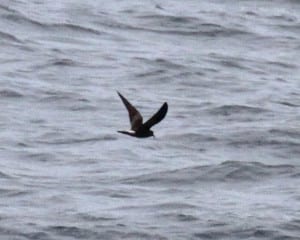 Storm-Petrels and a good chance to study the Chapman’s (variable but mainly dark-rumped) and Townsend’s (white-rumped) subspecies. Except for a handful of Red Phalaropes that was it for new species, and on this vast ocean it turned out to be quiet with only sparse birds for the last day and a half. The only real disappointments were missing Guadalupe Murrulet (which had been at best only 50-50 in any event), and unfortunately never encountering a single one of the rare petrels.
Storm-Petrels and a good chance to study the Chapman’s (variable but mainly dark-rumped) and Townsend’s (white-rumped) subspecies. Except for a handful of Red Phalaropes that was it for new species, and on this vast ocean it turned out to be quiet with only sparse birds for the last day and a half. The only real disappointments were missing Guadalupe Murrulet (which had been at best only 50-50 in any event), and unfortunately never encountering a single one of the rare petrels.
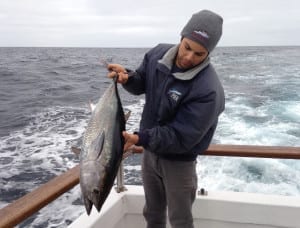 Each day one of the crew members would attach a couple of deep sea fishing rods to the stern rail from which lures could be trolled while the boat traveled at eight knots. On the last day, as I was sitting next to it, one of the
Each day one of the crew members would attach a couple of deep sea fishing rods to the stern rail from which lures could be trolled while the boat traveled at eight knots. On the last day, as I was sitting next to it, one of the 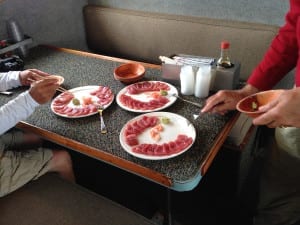 reels started to sing and the result turned out to be a 20-25 lb. bluefin tuna, and a few minutes late the other rod produced a second one. These were cleaned on deck, immediately put on ice, and everyone aboard got to enjoy the freshest possible, highest quality ice-cold sashimi (complete of course with chopsticks, pickled ginger, and wasabi) at the daily afternoon 4 PM snack time.
reels started to sing and the result turned out to be a 20-25 lb. bluefin tuna, and a few minutes late the other rod produced a second one. These were cleaned on deck, immediately put on ice, and everyone aboard got to enjoy the freshest possible, highest quality ice-cold sashimi (complete of course with chopsticks, pickled ginger, and wasabi) at the daily afternoon 4 PM snack time.
The boat delivered us back at Fisherman’s Landing at 6 AM, which left the entire rest of the day for spots around San Diego. After a round of good-byes, and a cab-ride back to Alamo to re-rent a car, our first stop was at the Tijuana River Valley Bird and Butterfly Garden to look for the small group of Black-throated Magpie-Jays there, but no luck, so we contented ourselves with two Allen’s Hummingbirds (female and juvenile) while we hoped the jays might appear. Just as we were about to leave, in a most timely fashion a truck pulled up and “Larry” affirmed for us that the jays do in fact show up daily for a half-hour at a time here and there and agreed to call us in real time on my cell phone if and when they appeared that day. We checked out the Daisy Mart Road estuary and heard (but did not see) two Bell’s Vireos (“least” subspecies)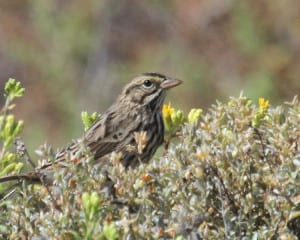 and watched a White-tailed Kite kiting for several minutes. Then we returned to Tijuana Slough, but it was high tide – not ideal for rails, so we decided to come back later after 1 PM when the tide would be low, and instead checked out Imperial Beach at the end of Seacoast Drive where we had good views of Belding’s subspecies of Savannah Sparrow.
and watched a White-tailed Kite kiting for several minutes. Then we returned to Tijuana Slough, but it was high tide – not ideal for rails, so we decided to come back later after 1 PM when the tide would be low, and instead checked out Imperial Beach at the end of Seacoast Drive where we had good views of Belding’s subspecies of Savannah Sparrow.
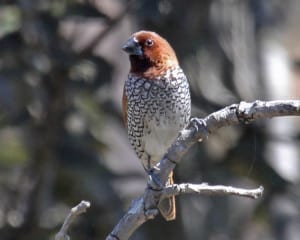 Next we paid a visit to Tecolote Natural Park to look for the last species (besides parrots) on my San Diego “hope to find” list – Scaly-breasted Munia, AKA Nutmeg Mannikin (7), a species added to the ABA checklist in 2013. I spotted a pair almost right away no more than a hundred yards or so along the trail. After lunch, it was back to Tijuana Slough at low tide for hopefully better views of Ridgway’s Rail. We had just sat down on a bench to admire the marsh panorama when we got lucky. Scanning around I happened to just notice a few blades of grass moving ever so slightly. Although nothing was in view, the grass movement continued very slowly inching its way to the right, and at last a Ridgway’s Rail materialized out of the vegetation and began to forage in plain view no more than a stone’s throw from our bench.
Next we paid a visit to Tecolote Natural Park to look for the last species (besides parrots) on my San Diego “hope to find” list – Scaly-breasted Munia, AKA Nutmeg Mannikin (7), a species added to the ABA checklist in 2013. I spotted a pair almost right away no more than a hundred yards or so along the trail. After lunch, it was back to Tijuana Slough at low tide for hopefully better views of Ridgway’s Rail. We had just sat down on a bench to admire the marsh panorama when we got lucky. Scanning around I happened to just notice a few blades of grass moving ever so slightly. Although nothing was in view, the grass movement continued very slowly inching its way to the right, and at last a Ridgway’s Rail materialized out of the vegetation and began to forage in plain view no more than a stone’s throw from our bench.  I had just finished the rewarding photo session with this most accommodating rail, when my cell phone rang and it was Larry telling us that the Black-throated Magpie-Jays had just arrived. It took us just fifteen minutes to hightail it back to the Bird and Butterfly Garden where persistence was rewarded with an opportunity to watch and photograph these extraordinary large, colorful, gaudy jays, but they were gone again within fifteen minutes and if it hadn’t been for Larry’s generous heads-up we would have missed them entirely.
I had just finished the rewarding photo session with this most accommodating rail, when my cell phone rang and it was Larry telling us that the Black-throated Magpie-Jays had just arrived. It took us just fifteen minutes to hightail it back to the Bird and Butterfly Garden where persistence was rewarded with an opportunity to watch and photograph these extraordinary large, colorful, gaudy jays, but they were gone again within fifteen minutes and if it hadn’t been for Larry’s generous heads-up we would have missed them entirely.
Finally we drove up to Point Loma which, if you haven’t been there, has to have one of the most spectacular panoramic views in all of the United States. It closes at 5 PM, so we didn’t have time for much beyond enjoying the view, but our plan was to have an early dinner back near the Fisherman’s Landing and hope some parrots would fly in to their evening roosts there. As it 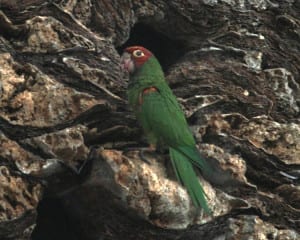 began to darken, sure enough we heard squawking and a flock of fourteen noisy psittacids flew in to a tree across the street. I had actually hoped for Lilic-crowned Parrots, but they tend to be more singular, and indeed these all turned out to be Red-masked Parakeets, a species I have seen in Florida. Before I had to head to the airport on Saturday morning, we had time to return to the end of Seacoast Drive where I walked several hundred yards south along the berm hoping to spot some Snowy Plovers on the beach, but of the various species noted Snowy Plovers this day were not among them.
began to darken, sure enough we heard squawking and a flock of fourteen noisy psittacids flew in to a tree across the street. I had actually hoped for Lilic-crowned Parrots, but they tend to be more singular, and indeed these all turned out to be Red-masked Parakeets, a species I have seen in Florida. Before I had to head to the airport on Saturday morning, we had time to return to the end of Seacoast Drive where I walked several hundred yards south along the berm hoping to spot some Snowy Plovers on the beach, but of the various species noted Snowy Plovers this day were not among them.
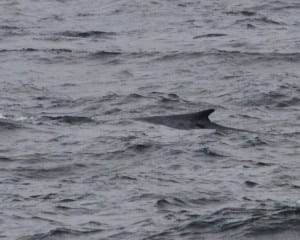
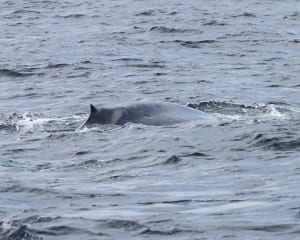 The four day outing on the “Searcher” also produced its share of mammal sightings, including Risso’s, Bottlenosed, and Short-beaked Common Dolphins, Elephant Seal, Guadalupe Fur Seal, California Sea Lion, and three species of whales – Fin Whale, a pod of rarely seen Baird’s Beaked Whales (video), and a pod of Blue Whales, the largest living animal on earth.
The four day outing on the “Searcher” also produced its share of mammal sightings, including Risso’s, Bottlenosed, and Short-beaked Common Dolphins, Elephant Seal, Guadalupe Fur Seal, California Sea Lion, and three species of whales – Fin Whale, a pod of rarely seen Baird’s Beaked Whales (video), and a pod of Blue Whales, the largest living animal on earth.
I can’t say enough about the quality of the boat experience. The logistics and boarding were exceedingly well organized, the guides highly knowledgeable and experienced, the crew most congenial and helpful, the accommodations fine, and the food absolutely outstanding – truly restaurant quality. The only disappointment was no petrels, but such will always be the vagaries of this quixotic pursuit.
